Fuel System Overview
The fuel tank stores the fuel supply. The fuel pump module, located in the fuel tank, supplies fuel through the fuel feed pipe to the high pressure fuel pump. The high pressure fuel pump supplies fuel to a variable-pressure fuel rail. Fuel enters the combustion chamber through precision multi-hole fuel injectors. The in-tank fuel pump is controlled with a fuel pump control module (FPCM). The engine control module (ECM) enables the FPCM and sends the desired fuel line pressure to the FPCM via GMLAN. The FPCM sends a pulse width modulated (PWM) voltage to the in-tank fuel pump allowing the fuel line pressure to be varied as commanded by the ECM. The high pressure fuel pump, fuel rail pressure, fuel injection timing, and injection duration are controlled by the ECM.
Fuel Tank
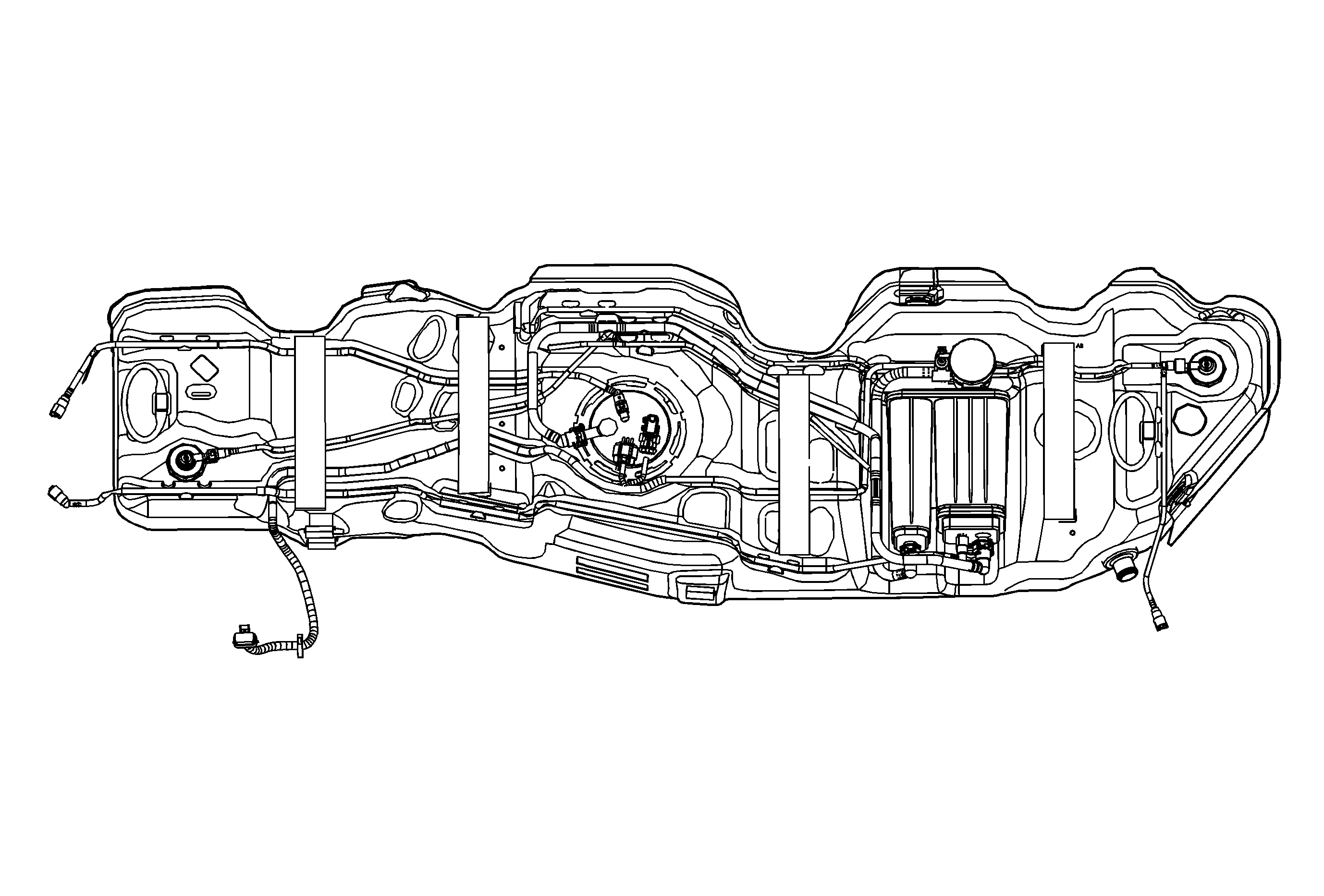
The fuel storage tank is made of high density polyethylene. The fuel storage tank is held in place by metal straps that are attached to the under body of the vehicle. The tank shape includes a sump in order to maintain a constant supply of fuel around the fuel pump strainer during low fuel conditions or during aggressive maneuvers.
On-Board Refueling Vapor Recovery (ORVR) System
The on-board refueling vapor recovery (ORVR) system is an on-board vehicle system to recover fuel vapors during the vehicle refueling operation. The flow of liquid fuel down to the fuel tank filler neck provides a liquid seal. The purpose of ORVR is to prevent refueling vapor from exiting the fuel tank filler neck. The ORVR components are listed below, with a brief description of their operation:
| • | The fuel tank--The fuel tank contains the modular fuel sender assembly. |
| • | The fuel filler pipe--The fuel filler pipe carries fuel from the fuel nozzle to the fuel tank. |
| • | The evaporative emission (EVAP) canister--The EVAP canister receives refueling vapor from the fuel system, stores the vapor, and releases the vapor to the engine upon demand. |
| • | The vapor lines--The vapor lines transport fuel vapor from the tank assembly to the EVAP canister and engine. |
| • | The check valve--The check valve limits fuel spit-back from the fuel tank during the refueling operation by allowing fuel flow only into the fuel tank. The check valve is located at the bottom of the fuel filler pipe. |
| • | The modular fuel sender assembly--The modular fuel sender assembly pumps fuel to the engine from the fuel tank. |
| • | The fuel tank pressure (FTP) sensor is located on top of the fuel sender assembly. |
| • | The FLVV--The FLVV acts as a shut-off valve. The FLVV is located in the fuel sender assembly. This valve has the following functions: |
| - | Controlling the fuel tank fill level by closing the primary vent from the fuel tank |
| - | Preventing fuel from exiting the fuel tank via the vapor line to the canister |
| - | Providing fuel spillage protection in the event of a vehicle rollover by closing the vapor path from the tank to the engine |
| • | The pressure vacuum relief valve--The pressure vacuum relief valve provides venting of excessive fuel tank pressure and vacuum. The valve is located in the fuel fill cap. |
| • | The vapor recirculation line--The vapor recirculation line is used to transport vapor from the fuel tank to the top of the fill pipe during refueling to reduce vapor loading to the enhanced EVAP canister. |
Fuel Tank Filler Pipe
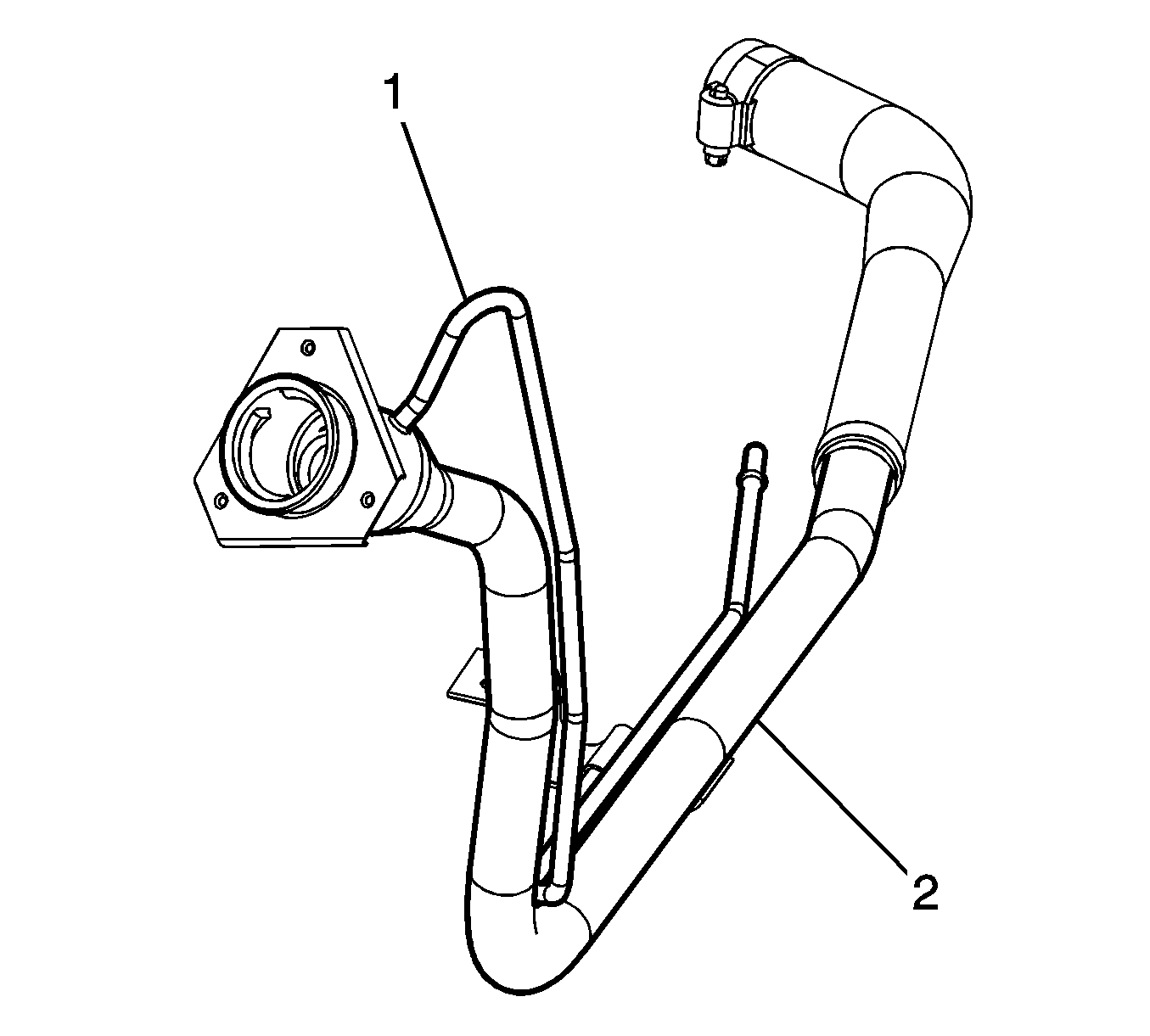
In order to prevent refueling with leaded fuel, the fuel filler pipe has a built-in restrictor and a deflector. The opening in the restrictor will accept only the smaller unleaded gasoline fuel nozzle which must be fully inserted in order to bypass the deflector. The tank is vented during filling by an internal vent tube inside of the filler pipe.
Fuel Filler Cap
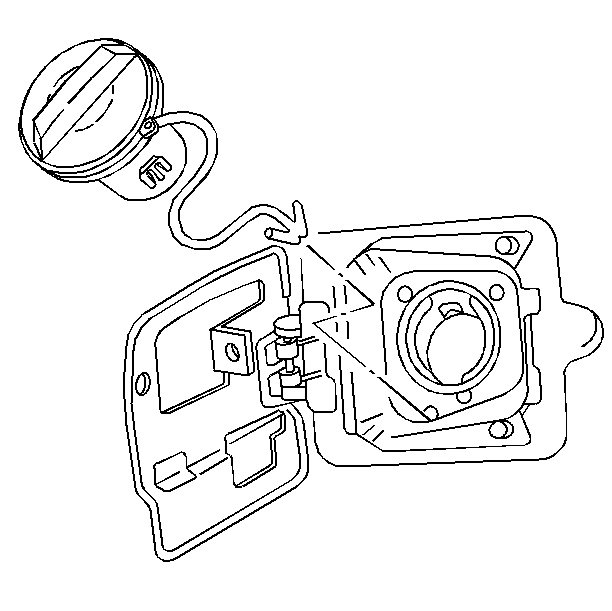
Caution: Use a fuel tank filler pipe cap with the same features as the original when a replacement is necessary. Failure to use the correct fuel tank filler pipe cap can result in a serious malfunction of the fuel system.
The fuel tank filler pipe is equipped with a turn to vent screw on the type cap which incorporates a ratchet action in order to prevent over-tightening.
The turn to vent feature allows the fuel tank pressure relief prior to removal. Instructions for proper use are imprinted on the cap cover. A vacuum safety relief valve is incorporated into this cap.
Fuel Sender Assembly
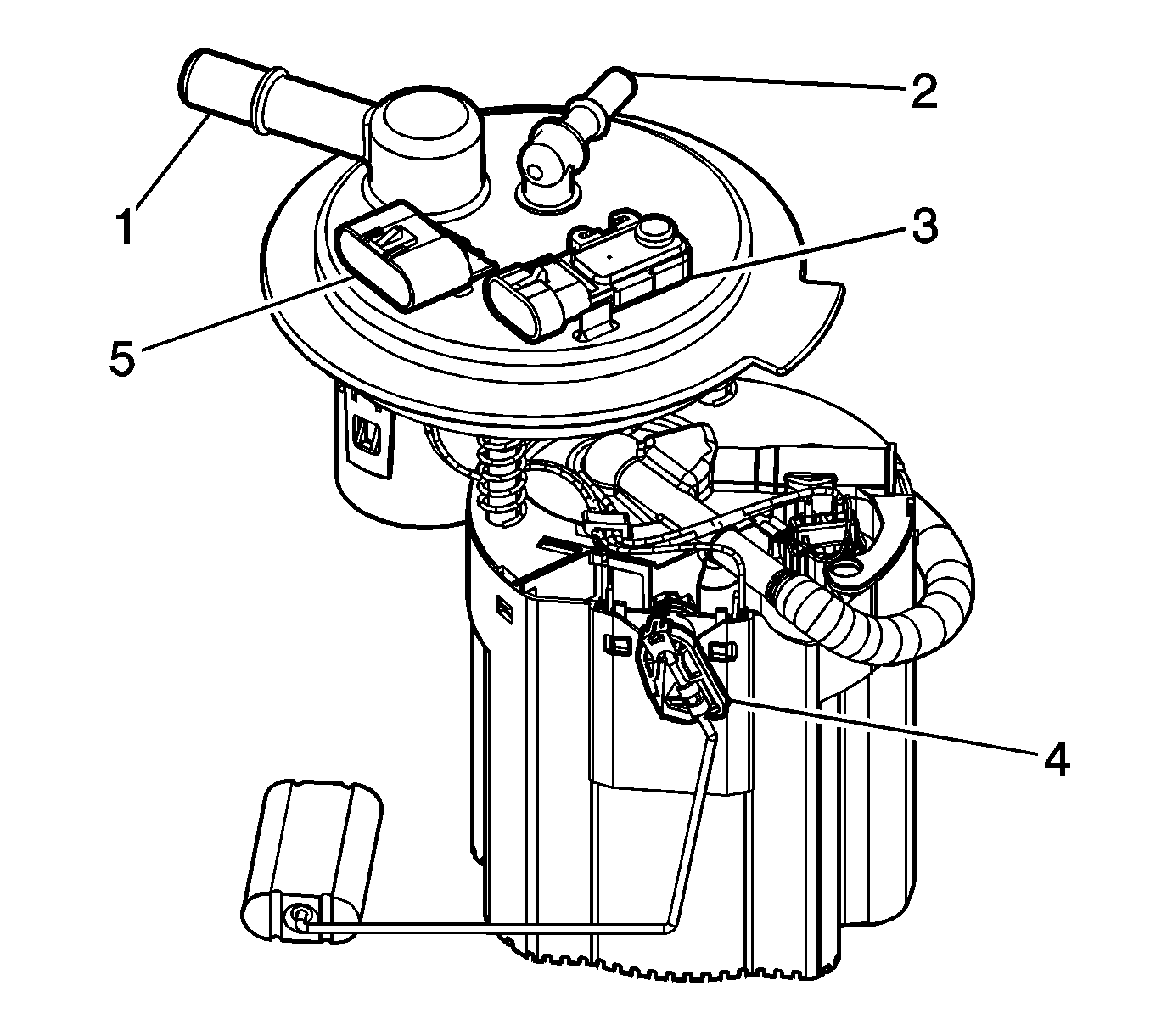
The fuel sender assembly consists of the following major components:
| • | The fill limit vent valve (1) |
| • | The fuel feed pipe (2) |
| • | The fuel tank pressure sensor (3) |
| • | The fuel level sensor (4) |
| • | The fuel pump electrical connector (5) |
The modular fuel sender assembly mounts to the threaded opening of the plastic fuel tank with a seal and a retainer ring. The reservoir, containing the exterior inlet strainer, the electric fuel pump and the fuel filter, maintains contact with the tank bottom. This design provides:
| • | Optimum fuel level in the integral fuel reservoir during all fuel tank levels and during driving conditions |
| • | An improved tank fuel level measuring accuracy |
| • | An improved coarse straining and added pump inlet filtering |
| • | More extensive internal fuel pump isolation for noiseless operation |
Fuel Pump
The electric fuel pump is a turbine pump which is located inside of the modular fuel sender. The electric fuel pump operation is controlled by the fuel pressure control module (FPCM).
Fuel Sender Strainer
The strainer acts as a coarse filter to perform the following functions:
| • | Filter contaminants |
| • | Separate water from fuel |
| • | Provide a wicking action that helps draw fuel into the fuel pump |
Fuel stoppage at the strainer indicates that the fuel tank contains an abnormal amount of sediment or water. Therefore, the fuel tank will need to be removed and cleaned, and the filter strainer should be replaced.
Fuel Pump Flow Control Module (FPCM)
The fuel pump flow control module (FPCM) is a serviceable GMLAN module. The FPCM receives the desired fuel pressure message from the engine control module (ECM) and controls the fuel pump located within the fuel tank to achieve the desired fuel pressure. The FPCM sends a PWM signal to the fuel pump, and pump speed is changed by varying the duty cycle of this signal.
Liquid Fuel Pressure Sensor - With FPCM
The fuel pressure sensor is a serviceable 5-volt, 3-pin device. It is located on the fuel feed line forward of the fuel tank, and receives power and ground from the fuel pump flow control module (FPCM) through a vehicle wiring harness. The sensor provides a fuel pressure signal to the FPCM, which is used to aid Closed Loop fuel pressure control.
Fuel Filter
The fuel filter is contained in the fuel sender assembly inside the fuel tank. The paper filter element of the fuel filter traps particles in the fuel that may damage the fuel injection system. The fuel filter housing is made to withstand maximum fuel system pressure, exposure to fuel additives, and changes in temperature. There is no service interval for fuel filter replacement.
EVAP Lines and Hoses
The EVAP line extends from the fuel tank vent valve to the EVAP canister and into the engine compartment. The EVAP line is made of nylon and connects to the EVAP canister with a quick connect fitting.
Pressure Vent Valve
The pressure vent valve replaces the typical fuel pressure regulator used on a mechanical returnless fuel system. The pressure vent valve is closed during normal vehicle operation. The pressure vent valve is used to vent pressure during hot soaks and also functions as a fuel pressure regulator in the event of the fuel pump flow control module defaulting to 100 percent pulse width modulation (PWM) of the fuel pump. Due to variation in fuel system pressures, the opening pressure for the pressure vent valve is set higher than the pressure that is used on a mechanical returnless fuel system pressure regulator.
High Pressure Fuel Pump
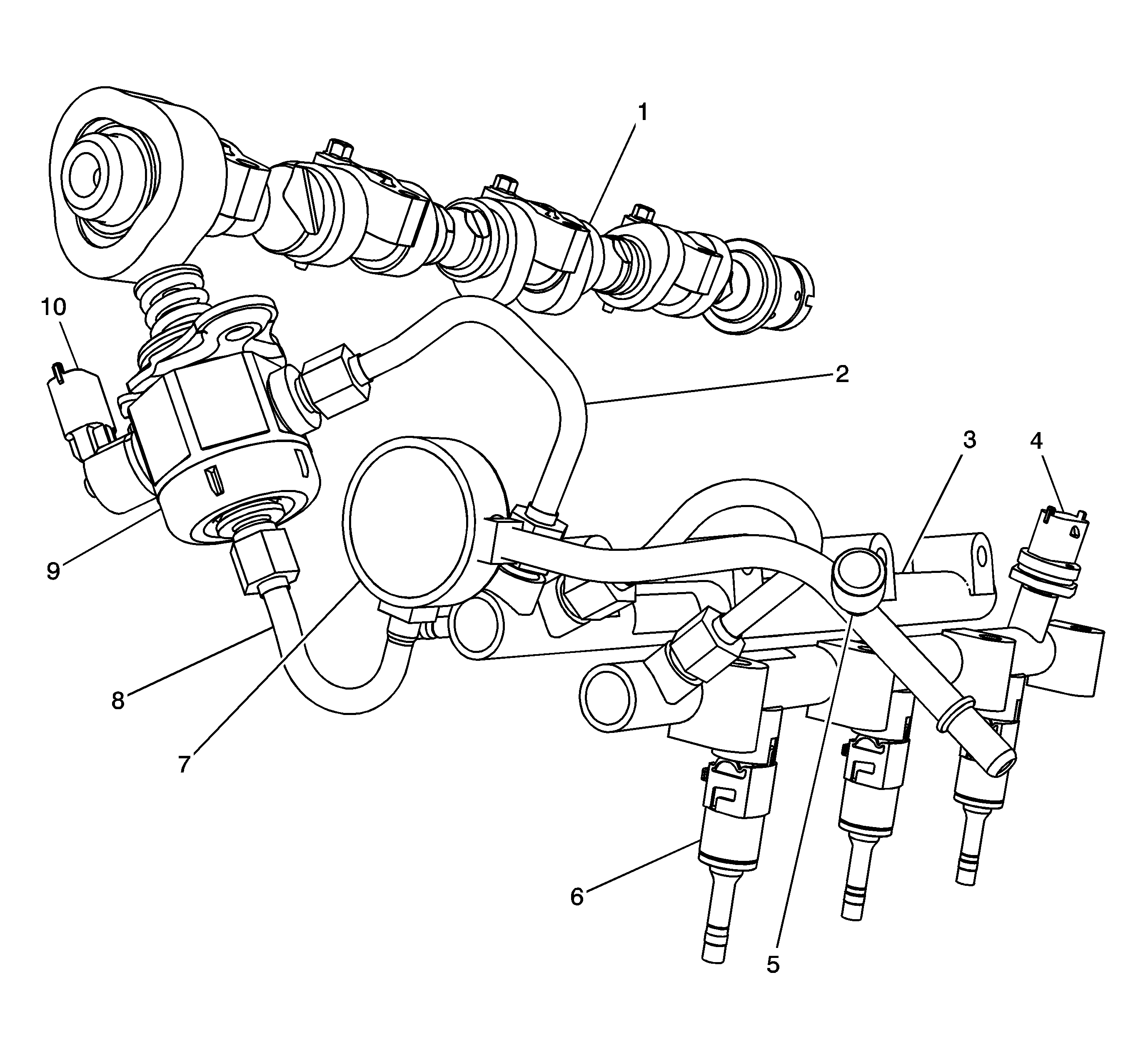
The high pressure fuel pump (9) is a mechanical one cylinder design driven by an eccentric on the exhaust camshaft (1) of bank 2. High pressure fuel is regulated by the fuel rail pressure (FRP) regulator, which is a part of the high pressure fuel pump. The FRP regulator is a magnetic actuator which controls the inlet valve of the high pressure pump. The ECM provides battery voltage on the actuator high circuit and ground on the actuator low reference circuit. Both circuits are controlled by the ECM. When the ECM deactivates the FRP regulator, both circuits are disabled and the inlet valve is held open with spring pressure. When the ECM activates the FRP regulator, the low circuit driver connects the low reference circuit to ground and the high circuit driver pulse-width modulates (PWM) the high circuit. The ECM uses the camshaft and crankshaft position sensor inputs to synchronize the FRP regulator with the position of the eccentric on the camshaft. The ECM regulates fuel pressure by adjusting the portion of each pump stroke that provides fuel to the rail. The high pressure fuel pump also contains an integrated pressure relief valve.
Fuel Rail Fuel Pressure Sensor
The fuel rail pressure sensor (4) detects fuel pressure within the fuel rail. The engine control module (ECM) provides a 5 volt reference voltage on the 5 volt reference circuit and ground on the low reference circuit. The ECM receives a varying signal voltage on the signal circuit. The ECM monitors the voltage on the FRP sensor circuits. When the fuel pressure is high, the signal voltage is high. When the fuel pressure is low, the signal voltage is low.
Fuel Rail Assembly
The fuel rail assembly (3) attaches to each cylinder head. The fuel rail distributes high pressure fuel to the fuel injectors. The fuel rail assembly consists of the following components:
| • | Six fuel injectors |
| • | A fuel rail pressure (FRP) sensor |
Fuel Injectors
The fuel injection system is a high pressure, direct injection, returnless on-demand design. The fuel injectors (6) are mounted in the cylinder head beneath the intake ports and spray fuel directly into the combustion chamber. Direct injection requires high fuel pressure due to the fuel injector's location in the combustion chamber. Fuel pressure must be higher than compression pressure requiring a high pressure fuel pump. The fuel injectors also require more electrical power due to the high fuel pressure. The ECM supplies a separate high voltage supply circuit and a driver circuit for each fuel injector.
The fuel injector assembly is an inside opening electrical magnetic injector. The injector has six precision machined holes that generate a cone shaped oval spray pattern. The fuel injector has a slim extended tip in order to allow a sufficient cooling jacket in the cylinder head.
The fuel injectors will cause various driveability conditions if the following conditions occur:
| • | If the injectors will not open |
| • | If the injectors are stuck open |
| • | If the injectors are leaking |
| • | If the injectors have a low coil resistance |
Engine Fueling
The engine is fueled by six individual injectors, one for each cylinder, that are controlled by the ECM. The ECM controls each injector by energizing the injector coil for a brief period once every other engine revolution. The length of this brief period, or pulse, is carefully calculated by the ECM to deliver the correct amount of fuel for proper driveability and emissions control. The period of time when the injector is energized is called the pulse width and is measured in milliseconds, thousandths of a second.
While the engine is running, the ECM is constantly monitoring the inputs and recalculating the appropriate pulse width for each injector. The pulse width calculation is based on the injector flow rate, mass of fuel the energized injector will pass per unit of time, the desired air/fuel ratio, and actual air mass in each cylinder and is adjusted for battery voltage, short term, and long term fuel trim. The calculated pulse is timed to occur as each cylinders intake valves are closing to attain largest duration and most vaporization.
Fueling during a crank is slightly different than fueling during an engine run. As the engine begins to turn, a prime pulse may be injected to speed starting. As soon as the ECM can determine where in the firing order the engine is, the ECM begins pulsing the injectors. The pulse width during the crank is based on the coolant temperature and the engine load.
The fueling system has several automatic adjustments in order to compensate for the differences in the fuel system hardware, the driving conditions, the fuel used, and the engine aging. The basis for the fuel control is the pulse width calculation that is described above. Included in this calculation are an adjustment for the battery voltage, the short term fuel trim, and the long term fuel trim. The battery voltage adjustment is necessary since the changes in the voltage across the injector affect the injector flow rate. The short term and the long term fuel trims are fine and coarse adjustments to the pulse width that are designed in order to maximize the driveability and emissions control. These fuel trims are based on the feedback from the oxygen sensors in the exhaust stream and are only used when the fuel control system is in a Closed Loop operation.
Under certain conditions, the fueling system will turn OFF the injectors for a period of time. This is referred to as fuel shut-off. Fuel shut-off is used in order to improve traction, save fuel, improve emissions, and protect the vehicle under certain extreme or abusive conditions.
In case of a major internal problem, the ECM may be able to use a back-up fuel strategy for limp in mode that will run the engine until service can be performed.
Sequential Fuel Injection (SFI)
The ECM controls the fuel injectors based on information that the ECM receives from several information sensors. Each injector is fired individually in the engine firing order, which is called sequential fuel injection. This allows precise fuel metering to each cylinder and improves the driveability under all of the driving conditions.
The ECM has several operating modes for fuel control, depending on the information that has been received from the sensors.
Starting Mode
When the ECM detects reference pulses from the CKP sensor, the ECM will enable the fuel pump. The fuel pump runs and builds up pressure in the fuel system. The ECM then monitors the MAF, IAT, engine coolant temperature (ECT), and the throttle position (TP) sensor signal in order to determine the required injector pulse width for starting.
Clear Flood Mode
If the engine is flooded with fuel during starting and will not start, the Clear Flood Mode can be manually selected. To select Clear Flood Mode, push the accelerator to wide open throttle (WOT). With this signal, the ECM will completely turn OFF the injectors and will maintain this stage as long as the ECM indicates a WOT condition with engine speed below 1,000 RPM.
Run Mode
The Run Mode has 2 conditions: Open Loop operation and Closed Loop operation. When the engine is first started and the engine speed is above 480 RPM, the system goes into Open Loop operation. In Open Loop operation, the ECM ignores the signals from the oxygen sensors and calculates the required injector pulse width based primarily on inputs from the MAF, IAT and ECT sensors.
In Closed Loop, the ECM adjusts the calculated injector pulse width for each bank of injectors based on the signals from each oxygen sensor.
Acceleration Mode
The ECM monitors the changes in the TP and the MAF sensor signals in order to determine when the vehicle is being accelerated. The ECM will then increase the injector pulse width in order to provide more fuel for improved performance.
Deceleration Mode
The ECM monitors changes in TP and MAF sensor signals to determine when the vehicle is being decelerated. The ECM will then decrease injector pulse width or even shut OFF injectors for short periods to reduce exhaust emissions, and for better (engine braking) deceleration.
Battery Voltage Correction Mode
The ECM can compensate in order to maintain acceptable vehicle driveability when the ECM sees a low battery voltage condition. The ECM compensates by performing the following functions:
| • | Increasing the injector pulse width in order to maintain the proper amount of fuel being delivered |
| • | Increasing the idle speed to increase the generator output |
Fuel Shut-Off Mode
The ECM has the ability to completely turn OFF all of the injectors or selectively turn OFF some of the injectors when certain conditions are met. These fuel shut-off modes allow the ECM to protect the engine from damage and also to improve the vehicles driveability.
The ECM will disable all of the six injectors under the following conditions:
| • | Ignition OFF--Prevents engine run-on |
| • | Ignition ON but no CKP signal--Prevents flooding or backfiring |
| • | A high engine speed--Above the red line |
| • | A high vehicle speed--Above the rated tire speed |
| • | Closed throttle cast down--Reduces the emissions and increases engine braking. |
The ECM will selectively disable the injectors under the following conditions:
| • | The torque management enabled--Transmission shifts or abusive maneuvers. |
| • | The traction control enabled--In conjunction with the front brakes applying |
